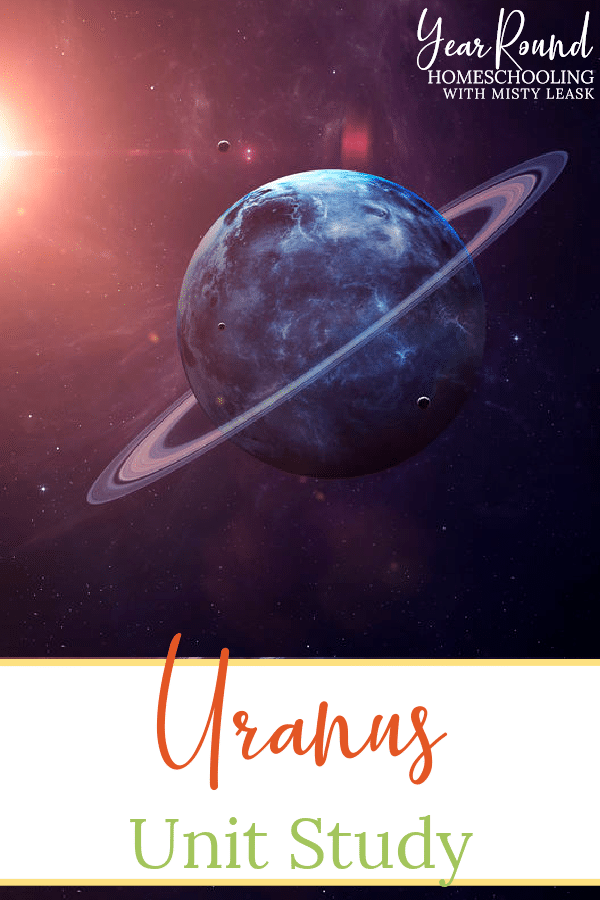Uranus is a unique planet, to begin with, because it sits differently in the sky. Your kids will learn all about this icy, blue planet through this Uranus Unit Study!

While science has never been my favorite subject to study or to teach, I discovered that the planets and stars were topics I truly enjoyed both learning about and teaching.
Your homeschool science class doesn’t have to be filled with memorizing or learning technical facts, lab projects or textbooks you need a dictionary to decipher. Science is supposed to be fun, fill you with wonder and encourage your kids (and you!) to explore!
The Solar System is amazing and you don’t have to be a scientist to know that. An evening spent laying outside underneath the night sky is all you need to understand the beauty it holds.
Uranus Unit Study
Uranus
William Herschel was the first astronomer to discover a planet, Uranus, with the use of a telescope in 1781. However, it wasn’t until 2 years later that Uranus was accepted as a new planet.
Uranus is an ice giant that has the shortest day in our Solar System. It is nearly 4 times bigger than our planet, Earth!
As with many planets, Uranus has a nickname. It is known as the “Sideways Planet” because it rotates on its side on a nearly 90-degree angle. This tilt causes extreme seasons to occur on the planet. One side of Uranus receives direct sunshine for nearly 20 years at a time, while the other side experiences a frigid, cold winter.
- Name
While the planet Uranus is named after a Greek god, originally the astronomer that discovered the planet wanted to name it after King George III.
- Size
Uranus is the 3rd largest planet in our solar system.
-
- Radius
The radius of Uranus is 15,759.2 miles, making it 4x wider than our home planet, Earth! To find the radius of a planet you need the distance from the center to the edge of the planet. You can figure out the radius if you know the circumference, diameter or area using these formulas.
-
- Diameter
In order to find the diameter of Uranus, you’ll need to take the radius and multiply it times 2. In doing so, you’ll find that Uranus’s diameter is 31,518.4 miles.
-
- Mass
At 8.68 x 1025, Uranus is 14.5 times more massive than Earth. Be sure not to confuse mass with weight. The difference between weight and mass is that weight is determined by the pull of gravity on an object.
-
- Volume
The volume of Uranus is 6.83×1013 cubic kilometers. You could fit 63 Earth’s inside of Uranus! The measure of volume determines how much space a three-dimensional object such as a planet occupies. To find Uranus’s volume on your own you’ll need this mathematical formula, V = 4/3 pi x r^3, and the radius of the planet.
-
- Surface area
Uranus has a surface area of 3,120,894,516 square miles. The find the surface area requires you to determine what number of square units will exactly cover the surface of a sphere. You’ll need this formula to determine Saturn’s surface area, (or any sphere) on your own.
-
- Density
The density of Uranus is 1.27 g/cm3, making it the 2nd least dense planet in the Solar System. You can convert the density of Uranus to lbs/gallons using this conversion tool.
- Rings
Uranus has two sets of rings; an outer and an inner set, for a total of 13 rings. They vary in color based on their location and include grey, reddish and blue.
- Moons
Most of the moons in our Solar System are named after mythology, but Uranus’ moons are named after characters in Shakespeare and Alexander Pope’s works.
- Location in the Solar System
Uranus is the seventh planet from the sun.
- Distance from the sun
Since planets are always moving, how far they are from the sun changes. However, on average Uranus is 1,793,610,684 miles away from the sun.
- Light time from the sun
It takes 2 hours and 40 minutes for light from the sun to reach Uranus.
- Layers
Since Uranus is an ice giant, it doesn’t really have a surface. At least 80 percent of Uranus is made up of “icy” materials including; water, methane and ammonia. The core of Uranus is small and rocky.
- Temperature
Uranus has the coldest atmosphere in the Solar System with the average temperature being -371 degrees Fahrenheit. Inside the planet, however, it is a different story with the core heating up to 9,000 degrees Fahrenheit!
- Speed
The planet Uranus travels 15,209 miles per hour as it makes its way around the sun. That means in one 24 hour day on Earth, Uranus travels 365,016 miles!
- Orbit
It takes approximately 84 years on Earth for Uranus to complete one trip around the sun.
- Axis Rotation
One day or a complete axis rotation for Uranus takes only 17 hours.
- Atmosphere
While helium and hydrogen dominate the planet’s atmosphere, methane, water and ammonia are present. Uranus gets its blue color due to the presence of methane in its atmosphere.
Please note, that some of the resources below may include evolutionary information. I encourage you to have a conversation with your children or preview these resources prior to assigning them as part of your homeschool studies.
Articles
Literature
 UranusShop on Amazon
UranusShop on Amazon Are We There Yet? All About...Shop on Amazon
Are We There Yet? All About...Shop on Amazon Planet Uranus (A True Book:...Shop on Amazon
Planet Uranus (A True Book:...Shop on Amazon Why Is Uranus Upside Down?:...Shop on Amazon
Why Is Uranus Upside Down?:...Shop on Amazon Uranus (Planets in Our Sola...Shop on Amazon
Uranus (Planets in Our Sola...Shop on Amazon Uranus (Planets)Shop on Amazon
Uranus (Planets)Shop on Amazon The Secrets of Uranus (Plan...Shop on Amazon
The Secrets of Uranus (Plan...Shop on Amazon Uranus: The Ice Planet (Our...Shop on Amazon
Uranus: The Ice Planet (Our...Shop on Amazon Your Mission to Uranus (The...Shop on Amazon
Your Mission to Uranus (The...Shop on Amazon Uranus: Planets in Our Sola...Shop on Amazon
Uranus: Planets in Our Sola...Shop on Amazon Uranus (The University of A...Shop on Amazon
Uranus (The University of A...Shop on Amazon The Sideways Planet: UranusShop on Amazon
The Sideways Planet: UranusShop on Amazon Uranus (My Early Library: M...Shop on Amazon
Uranus (My Early Library: M...Shop on Amazon Uranus (First Book)Shop on Amazon
Uranus (First Book)Shop on Amazon Uranus (Space Neighbors)Shop on Amazon
Uranus (Space Neighbors)Shop on Amazon Uranus (Bullfrog Books: Spa...Shop on Amazon
Uranus (Bullfrog Books: Spa...Shop on Amazon Uranus: Cold and Blue (Out ...Shop on Amazon
Uranus: Cold and Blue (Out ...Shop on Amazon
Videos
Art
Craft
Games and Activities
Printables
What did your kids enjoy learning the most through your Uranus unit study?

